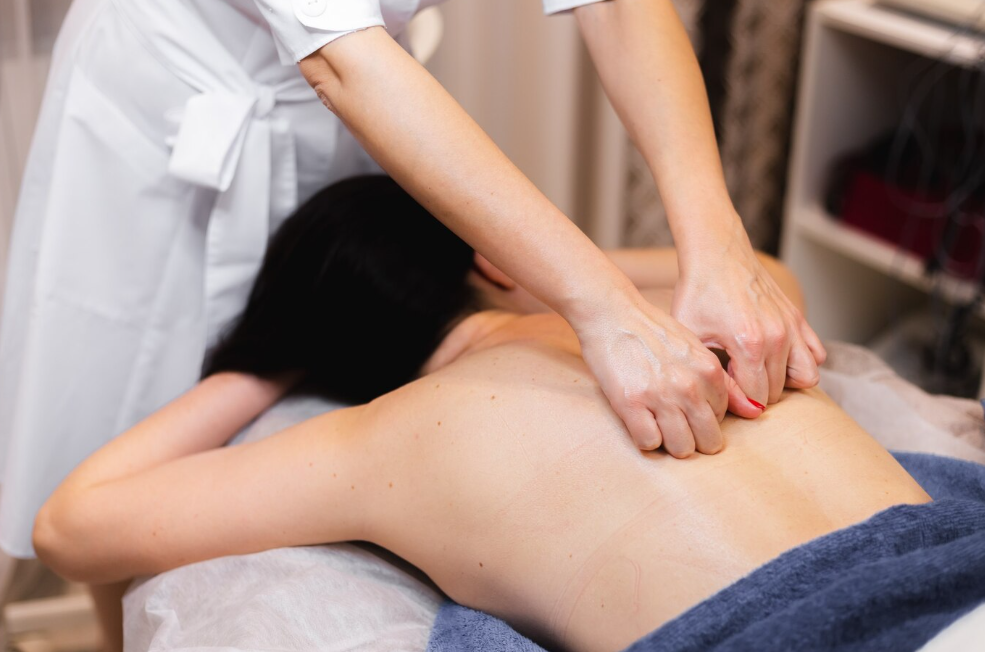Have you ever had an old injury flare up out of nowhere? Do you have a stubborn scar that still feels tight and uncomfortable years later? Scar tissue forms as our body heals from an injury, but it doesn’t always heal in an ideal way. Scar tissue massage is a technique used by registered massage therapists to help break up thick, inflexible scar tissue and adhesions under the skin.
By applying gentle pressure and massage techniques directly to the scar and surrounding area, scar tissue massage can help loosen tight scar tissue, increase blood flow, relieve pain, and restore mobility and range of motion. If you’ve been living with the discomfort of scar tissue for too long, it may be time to consider scar tissue therapy and management.
What is Scar Tissue and How Does it Form?
Scar tissue forms when your skin is injured. As your body heals the wound, it produces collagen fibers that bind the damaged tissue back together. This collagen buildup creates raised firm scar tissue.
The scar tissue that forms after an injury isn’t as flexible or stretchy as normal skin. It can tighten and harden over time, limiting your range of motion and causing pain. This massage helps break up these collagen fibers and adhesions, restoring flexibility and mobility.
You’ve likely noticed scars on your own body, whether from surgeries, injuries, burns, or skin conditions like acne or eczema. Scars come in many shapes and sizes, from fine lines to thick, raised hypertrophic scars to stretched marks. The appearance of a scar depends on factors like the severity and depth of the original wound, your age and skin type, and the location of the body.
Scar tissue massage uses deep tissue techniques to break up collagen cross-links and adhesions under the skin. A massage therapist applies firm pressure and friction to loosen the scar tissue and surrounding fascia. This helps relieve tightness, reduce pain, and improve range of motion. Regular massage, especially when combined with silicone gels or sheets, can significantly improve the appearance, texture, and elasticity of scars over time.
While professional massages provide the best results, you can also perform self-massage at home using your fingers or handheld tools like scar massage rollers or balls. Be gentle and go slowly, increasing pressure and intensity over time as the scar tissue softens. With regular massage, your scars may become less visible and painful, restoring comfort and confidence in your own skin.
Benefits of Scar Tissue Massage
Scar tissue massage provides many benefits for both your physical and mental health. Here are some of the key benefits you can gain from regular scar tissue massage treatments:
1. Increased Range of Motion
Scar tissue can adhere to underlying tissues and restrict movement. Massage helps loosen these adhesions and restore flexibility. You’ll find daily tasks become easier again and you have a wider range of motion.
2. Reduced Pain
Scar tissue massage releases trigger points and loosen tight fascia, muscles and connective tissue. This can significantly decrease pain from scars, especially those from injuries or surgeries. Massage also increases blood flow to the area, which reduces inflammation and promotes healing.
3. Improved Appearance
Massaging scar tissue helps soften and flatten the scar, making it less visible and more pliable. It helps the scar tissue blend in better with the surrounding skin. For scars that have caused asymmetry or muscle atrophy, massage can help restore balance and shape.
4. Decreased Stress and Anxiety
The massaging action activates your body’s relaxation response, releasing feel-good hormones like endorphins to lift your mood and ease anxiety. This massage also helps you become more aware of your body, which can help reduce fear and negative feelings toward the scarred area.
With regular treatment, scar tissue massage can produce dramatic improvements in both the softness and appearance of your scars, as well as enhance your range of motion, decrease pain, and promote an overall sense of wellbeing. Why not give it a try?
Self-Massage Techniques for Scar Tissue
Once your scar has healed, performing self-massage techniques can help soften and minimize the scar tissue. Massaging the scar tissue helps break up collagen cross-links, increases pliability, and improves mobility. The earlier you start massage, the more effective it will be.
1. Friction Massage
Use your index and middle fingers to apply small circular motions directly on the scar. Start with light pressure, gradually building up as the scar tissue softens. Massage for 5 to 10 minutes a day, a few times per week. The friction helps loosen adhesions and realign collagen fibers.
2. Cross-Fiber Massage
Place two fingers on one side of the scar. Gently glide your fingers across the scar using small circular motions, moving from one side of the scar to the other. Use medium pressure and repeat for several minutes. This technique helps loosen tight bands of scar tissue that form perpendicular to the incision.
3. Deep Tissue Massage
Once scar mobility has improved, you can perform deeper massage techniques. Use your thumb, knuckles or heel of your hand to apply firm pressure while massaging along and across the length of the scar. Start at one end of the scar and work slowly to the other end using small circular motions. Repeat several times a week to further soften thickened scar tissue.
Also read: Benefits Of Deep Tissue Massage Therapy
4. Silicone Gel or Sheets
For added benefit, apply silicone gel, silicone sheets or silicone tape directly to the scar before performing massage techniques. The silicone works to soften scar tissue by hydrating the cells and increasing blood circulation. Perform massage after the silicone has been on for several hours or as directed. Silicone therapy, combined with massage, can produce significant improvements in scar thickness, pliability, and appearance.
With regular use of these self-massage techniques, especially when started soon after surgery, you can gain improvements in scar mobility, softening and appearance over several months. Be patient and consistent, as it can take weeks or months of regular massage to significantly remodel scar tissue. But the effort will be well worth the results!
When to Seek Professional Scar Tissue Massage
Sometimes scar tissue requires professional massage therapy to break up adhesions and restore mobility and function. If your scar tissue is causing pain, limited range of motion, or misalignment, it’s a good idea to seek help from a registered massage therapist (RMT).
An RMT who specializes in scar tissue massage uses specific techniques to loosen the fibrous bands of scar tissue that adhere to surrounding tissues like muscles, tendons, and nerves. They apply manual pressure, stretching and kneading motions to gently separate the layers of scar tissue and surrounding tissues. This helps to relieve pressure, reduce pain, and restore flexibility.
When should you consider scar tissue massage?
1. If your scar feels tight, hard, or tender and causes pain or discomfort. Scar tissue massage can help soften and desensitize the area.
2. If you have limited mobility or range of motion around the scar. The massage helps loosen the scar so you can move more freely.
3. If your scar has caused muscles or joints to become misaligned. Releasing the scar tissue can help bring everything back into proper alignment and function.
4. If you want to minimize the appearance of an unsightly scar. Massage helps soften and flatten the scar, improving its appearance.
5. If other treatments like medication, physical therapy or stretching haven’t provided relief. Scar tissue massage may be able to help where other options have failed.
While self-massage of scar tissue can provide some benefits, an RMT is trained to properly assess scars and apply the appropriate techniques for the best results. They can create a customized treatment plan based on the age, size and location of your scar. If you’re dealing with chronic pain or limited mobility from old or extensive scarring, scar tissue massage from an experienced therapist may be your path to relief and recovery.
Finding the Best RMT Massage Spa for Scar Tissue Therapy in Vancouver
Finding a registered massage therapist (RMT) in Vancouver who specializes in scar tissue therapy can make a big difference in your treatment and recovery. As with Goldilocks, you want to find one that’s “just right” for your needs.
Look for an RMT with advanced certifications or credentials in soft tissue therapy, myofascial release, or medical massage. These specialized skills, coupled with years of experience, will ensure they understand how to properly break up scar tissue adhesions and relax the surrounding muscles. Ask about their experience helping clients with scar tissue pain and mobility restrictions. An RMT well-versed in this area will have the proper techniques to reshape and rehydrate collagen fibers while minimizing discomfort.
You’ll also want to consider the overall atmosphere and vibe of the clinic. Do they focus on therapeutic and rehabilitative massage? If relaxation and pampering are the priority, scar tissue work may not be a strength. The ideal clinic will have a clinical yet inviting feel, with therapists who give you their full attention and make you feel comfortable discussing your condition and treatment goals.
A comprehensive initial assessment is key. The RMT should evaluate your scar, medical history, range of motion, and any pain patterns. They will then design a customized treatment plan to meet your needs. Multiple visits are typically required to fully break up scar tissue adhesions, so inquire about package rates or monthly memberships to make ongoing treatments more affordable.
With the right RMT and clinic, you can gain relief from scar tissue pain, improved mobility and function, reduced stiffness, and an overall improved quality of life. While the massage techniques may not be as relaxing as a spa treatment, the lasting benefits to your body and daily activities can be life-changing. With some research and patience finding the perfect RMT match, you’ll be well on your way to freeing yourself from the grip of stubborn scar tissue.
Also read: 10 Types of Therapeutic Massage and the Health Benefits of Massage Therapy
Conclusion
So there you have it, the lowdown on scar tissue massage and how it can help improve your mobility and flexibility. While scar tissue formation is a natural part of the healing process, the tight bands and adhesions it creates don’t have to be permanent. With the help of a registered massage therapist, you can break up scar tissue and restore normal function. The techniques may not be the most pleasant at first, but stick with it.
Your body will thank you, as it’s finally able to move without restriction and your range of motion returns. Scar tissue massage works, so don’t live with discomfort and limited movement if you don’t have to. Book your appointment today – your newfound freedom of movement awaits!
Frequently Asked Questions
1: What is scar tissue, and why does it need massage?
Scar tissue is the fibrous tissue that forms at the site of a wound or injury. It can cause stiffness and reduced range of motion. It helps break down these adhesions, improving flexibility and reducing pain.
2: How does a finger massager help with scar tissue?
A finger massager is a small, handheld tool used by registered massage therapists (RMTs) to target scar tissue directly. It helps apply focused pressure and promotes blood circulation, aiding in scar tissue breakdown.
3: Can I perform scar tissue massage at home, or should I visit an RMT spa?
While some self-massage techniques can be done at home, for the best results and safety, it’s advisable to visit an RMT spa. Registered massage therapists have the expertise to assess and treat scar tissue effectively.
4: Are there any specific benefits of scar tissue massage in Vancouver?
Scar tissue massage in Vancouver, provided by skilled RMTs, can offer enhanced pain relief, improved mobility, and faster recovery from injuries. It’s essential to choose the best RMT Vancouver has to offer for optimal results.
5: How frequently should I get scar tissue massage treatments?
The frequency of scar tissue therapy depends on the severity of your scar tissue and your RMT’s recommendations. Generally, multiple sessions are needed, and a personalized plan will be created for you to achieve the best results.





